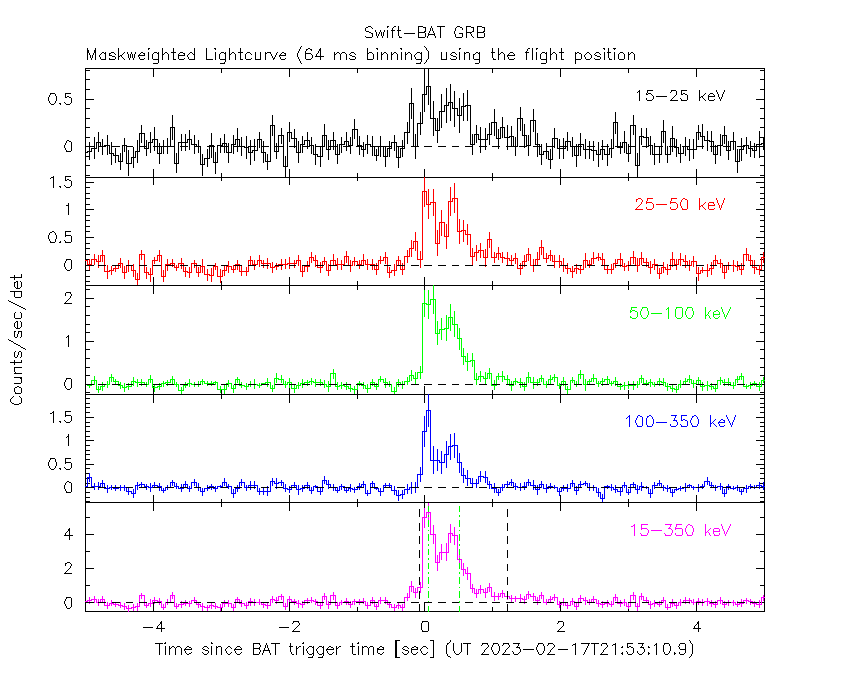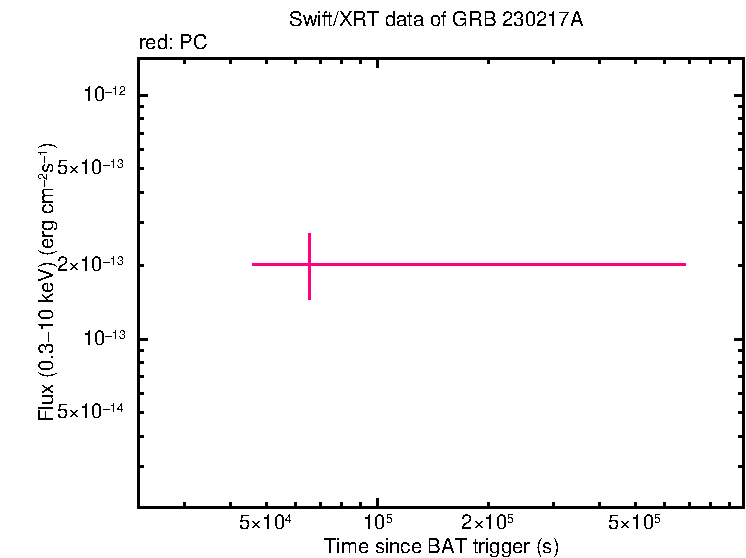
M.J. Moss (GWU), M. Capalbi (INAF-IASFPA) and F. T_start (s) for the Swift team
At 21:53:10 UT, the Swift Burst Alert Telescope (BAT) triggered and located GRB 230217A (trigger=1154967) (Moss et al. GCN Circ. 33339). Swift did not slew to the burst due to an observing constraint. At the time of the trigger, the initial BAT position was 49° from the Sun (3.3 hours West) and 16° from the 8%-illuminated Moon. Table 1 contains the best reported positions from Swift.
D'Avanzo et al. (GCN Circ. 33374) reported the position from VLT/FORS2 for the optical afterglow of this GRB. Table 2 is a summary of GCN Circulars about this GRB from observatories other than Swift.
Standard analysis products for this burst are available at https://gcn.gsfc.nasa.gov/swift_gnd_ana.html.
As reported by Barthelmy et al. (GCN Circ. 33363),
the BAT ground-calculated position is
RA, Dec = 280.759, -28.840 deg which is
RA(J2000) = 1
The mask-weighted light curve (Figure 1) shows a double-peaked event running from
T -0.2 s to about T+1.2 s.
The time-averaged spectrum from T-0.26 to T+1.75 s is best fit by a simple
power-law model.
The power law index of the time-averaged spectrum is
0.99 ± 0.12.
The fluence in the 15-150 keV band is 2.3 ± 0.2 x 1
The results of the batgrbproduct analysis are available at https://gcn.gsfc.nasa.gov/notices_s/1154967/BA/.
Analysis of the initial XRT data was reported by Capalbi et al. (GCN Circ. 33365). Of the sources reported by Capalbi et al. (GCN Circ. 33348), "Source 3" is fading with >3-sigma significance, and is therefore likely the GRB afterglow.
The light curve (Figure 2) can be modelled with a power-law decay with a decay index of α=1.1 (+0.6, -0.4).
A spectrum formed from the PC mode data can be fitted with an absorbed
power-law with a photon spectral index of 1.6 (+0.8, -0.4). The
best-fitting absorption column is consistent with the Galactic value
of 1.6 x 1
The Swift/UVOT began settled observations of the field of GRB 230217A 45.8 ks after the Swift/BAT trigger
(T_start et al. GCN Circ. 33370).
No optical afterglow consistent with the XRT position (Capalbi et al., GCN Circ. 33365) is detected in the initial UVOT exposures.
Table 3 gives preliminary
magnitudes using the UVOT photometric system
(Breeveld et al. 2011, AIP Conf. Proc., 1358, 373).
No correction has been made for the expected extinction in the Milky Way
corresponding to a reddening of

Figure 1. The BAT
mask-weighted light curve in the four individual and total
energy bands. The units are counts

Figure 2. The XRT light curve.
Any data from a crosshatched region are not included in the fit.
| RA (J2000) | Dec (J2000) | Error | Note | Reference |
|---|---|---|---|---|
| 1 |
-28°50'14.6" | 4.7" | XRT-final | UKSSDC |
| 1 |
-28°50'14.6" | 4.7" | XRT | Capalbi et al. GCN Circ. 33365 |
| 1 |
-28°50'23.0" | 1.3' | BAT-refined | Barthelmy et al. GCN Circ. 33363 |
| Band | Authors | GCN Circ. | Subject | Observatory | Notes |
|---|---|---|---|---|---|
| Optical | O'Connor and Troja | 33356 | Gemini-South Optical Observation | Gemini | |
| Optical | Troja and O’Connor | 33360 | Gemini South optical upper limits | Gemini | upper limits |
| Optical | Gillanders et al. | 33368 | Continued Gemini Observations | Gemini | |
| Optical | D'Avanzo et al. | 33374 | VLT/FORS2 optical observations and candidate counterpart |
VLT/FORS2 | detection |
| Radio | Schroeder et al. | 33358 | 6 GHz VLA observations | VLA | |
| Radio | Anderson et al. | 33433 | ATCA rapid-response radio detection | ATCA | detection |
| Gamma-ray | Fermi | 33338 | Fermi GBM Final Real-time Localization | Fermi GBM | |
| Gamma-ray | Casentini et al. | 33343 | AGILE/MCAL detection | AGILE | |
| Gamma-ray | Svinkin et al. | 33349 | Konus-Wind detection | Konus-Wind | Duration=~0.9 seconds Fluence=2.74(-0.35,+0.39)x1 |
| Gamma-ray | Veres | 33353 | Fermi GBM observation | Fermi GBM | Fluence=1.81±0.02x1 (brighter than 100% of short GRBs) |
| Gamma-ray | Navaneeth et al. | 33361 | AstroSat CZTI detection | CZTI |
| Filter | Exp(s) | Mag | ||
|---|---|---|---|---|
| wh | 45886 | 84347 | 2643 | >21.37 |
| u | 329962 | 342875 | 4884 | >20.78 |
Table 3. UVOT observations reported by T_start et al. (GCN Circ. 33370). The start and stop times of the exposures are given in seconds since the BAT trigger. The preliminary 3-σ upper limits are given. No correction has been made for extinction in the Milky Way.
March 10, 2023